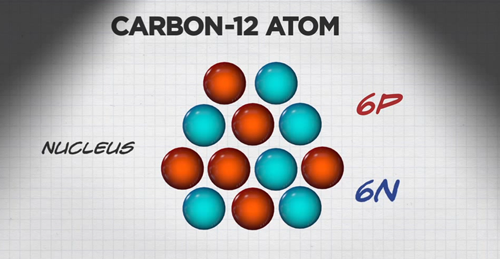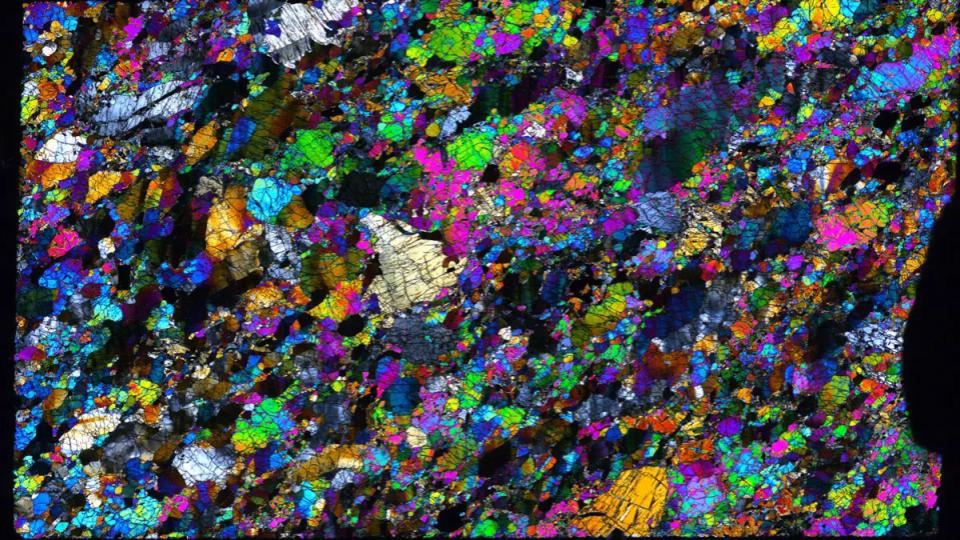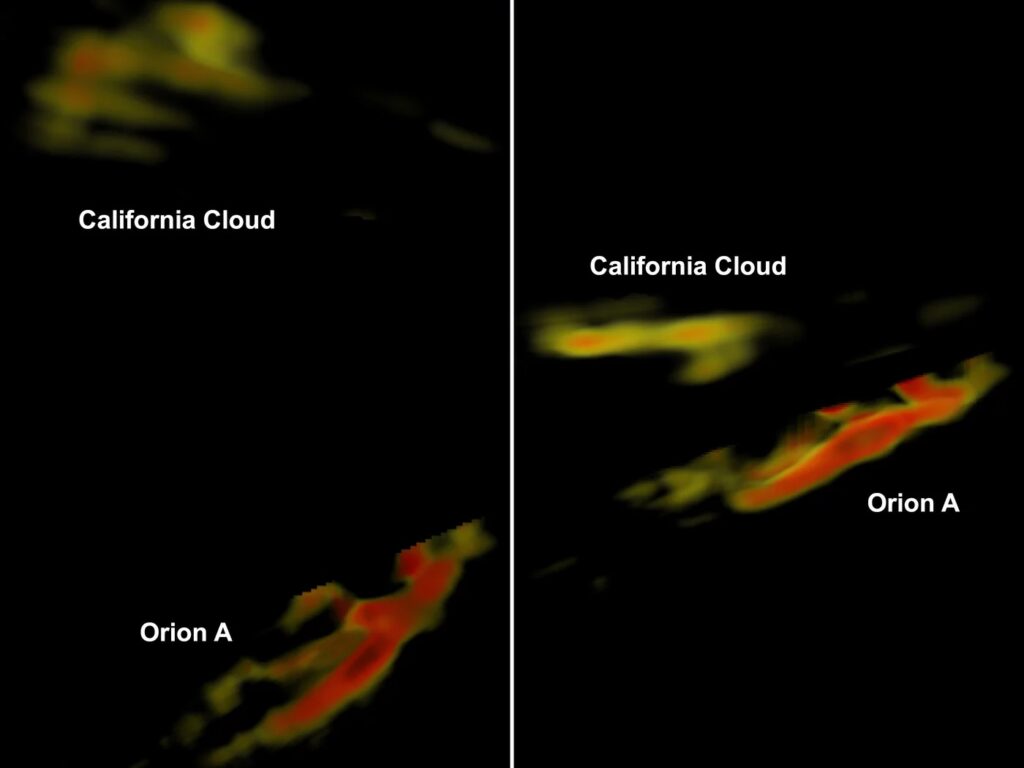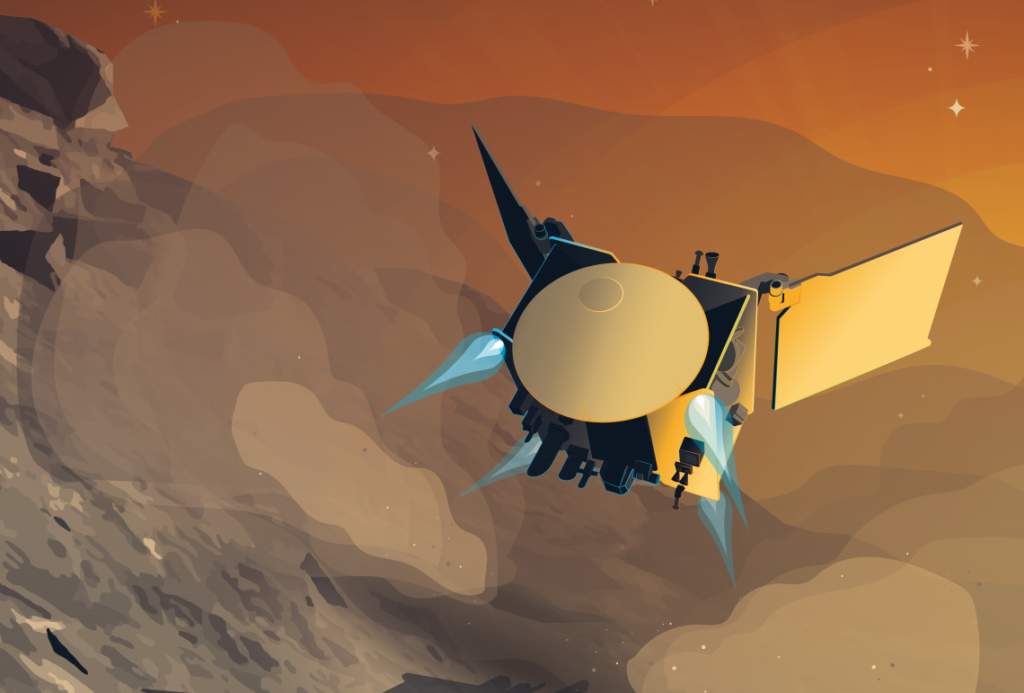A team of scientists combined stellar locations from the Gaia mission with dust and cloud maps from the WISE and 2MASS catalogs to create amazing three-dimensional images of the California Cloud and Orion A Cloud. Plus, rocket launches, the origin of carbon, and an interview with Dani DellaGiustina, principal investigator for the OSIRIS-APEX mission.
Podcast
Show Notes
More Starlink, as if we haven’t had enough of them
- Starlink 4-13 mission page (SpaceX)
- Starlink 4-15 mission page (SpaceX)
iSpace Hyperbola-1 fails again
Building block of life’s origin found
- Iowa State University press release
- “α-Clustering in atomic nuclei from first principles with statistical learning and the Hoyle state character,” T. Otsuka et al., 2022 April 27, Nature Communications
On the hunt to understand really old rocks
- Million or Billion? Narrowing Down the Age of Mantle Processes in New Guinea (Eos)
- “Ultra-Refractory Peridotites of Phanerozoic Mantle Origin: the Papua New Guinea Ophiolite Mantle Tectonites,” Natasha Barrett et al., 2022 February 23, Journal of Petrology
Astronomers map 3D cloud structures
- MPIA press release
- “Three-dimensional Shape Explains Star Formation Mystery of California and Orion A,” Sara Rezaei Kh. and Jouni Kainulainen, 2022 May 16, The Astrophysical Journal Letters
- “Detailed 3D structure of Orion A in dust with Gaia DR2,” Sara Rezaei Kh., Coryn A. L. Bailer-Jones, Juan D. Soler and Eleonora Zari, 2020 November 18, Astronomy & Astrophysics
Hubble catches giant in the head of the Serpent
- NASA Goddard image release
A small Sombrero for Hubble
- NASA Goddard image release
OSIRIS-REx gets a new mission, new name
- The University of Arizona press release
Transcript
Hey, Pamela – it happened again.
Ah, what happened?
Well, SpaceX launched a bunch more Starlink satellites over the weekend… again. And China’s Hyperbola rocket failed… again.
Yikes and double yikes.
But we do have science on the origin of carbon and rocks.
That’s better. I also found new 3-D images of interstellar blobs and filaments.
And Beth will be interviewing the new PI for the OSIRIS-REx mission extension.
All that and more, right here on the Daily Space.
I am your host Dr. Pamela Gay.
And I am your host Erik Madaus.
And we’re here to put science in your brain.

There were Starlink launches this weekend, of course – two launches each with 53 satellites. The first launched from SLC-4E at Vanderberg; the other SLC-40 at the Cape. One of them even used a brand new booster, which is unusual for Starlink. They usually fly on the boosters in the fleet with the most flights. Thirteen is the current record and that was a Starlink. Both boosters and sets of fairings were successfully recovered on their respective ships and brought back for additional flights.
The team liked the views from the first stage camera on the launch from the Cape, so here is a little long cut landing video, which as usual includes a few cuts to the second stage camera before the first stage touches down. So sit tight, don’t touch that dial, and watch a rocket come back from space.
Also over the weekend, Chinese company iSpace launched their fourth Hyperbola-1 rocket. Like the last three launch attempts, this one also ended in failure. No official reason for the failure was disclosed. State media outlet Xinhua only said that the “launch mission was abnormal”. Onboard was another Jilin-1 series satellite, to replace the one lost in the last Hyperbola-1 launch failure. The Hyperbola-1 rocket has worked once, but that was a smaller, less capable version of the rocket. All three attempts to launch the larger version have failed.
From the latest roundup of rocket news, we take you to a story about carbon, a building block of life.

Carl Sagan famously said that “we are all star stuff”, meaning the atoms and molecules that make us up as people, as creatures, as beings were all created in the violent explosions of stars. But understanding just how some of those elements came about has been a challenge to researchers. In a new paper published in Nature Communications, a team of scientists has uncovered just how one major life-building element – carbon-12 – was produced in those stellar explosions.
First off, there are three isotopes of carbon. We know of carbon-14 as a radioactive isotope used in dating organic material. The other two isotopes are carbon-12 and carbon-13, both of which are stable isotopes, meaning they don’t decay. Of those two, carbon-12 makes up over 90% of the naturally occurring carbon in our universe.
And in the paper, the team explains how four alpha particles – helium-4 atoms that have two protons and two neutrons – can cluster and eventually stabilize and form caron-12. They used first principles in their calculations, which is neat because it means they didn’t add anything we didn’t already know. And it means it can be assigned as a homework problem for some graduate student.
This is pure maths at its finest, and because it was rather complex maths, it took them over a decade to design the software and code and statistical learning techniques to crunch all the numbers.
Questions still remain about when and where the carbon-12 gets produced. Co-author James Vary is curious if these atoms come from the internal processes in stars or supernova explosions or even collisions between neutron stars. He notes: This nucleosynthesis in extreme environments produces a lot of stuff including carbon.
We look forward to seeing where this research goes in the coming years.

Understanding the origin and timing of life and world-building materials is important science. All of this work is tied together in the larger quest for understanding how life came about and can we find it elsewhere. A rock can tell you something new about the world and how it changed over time.
Now, using mantle rocks found in the jungles of New Guinea, researchers may have timed just when the mantle under that region melted.
These lowermost rocks are different from ones found elsewhere on Earth. They’re full of elements that generally don’t like to be in melted rock. They lack elements that do prefer to be in melted rock. So scientists thought that meant they were extremely old and formed during the Archean epoch – about 2.5 to 4 billion years ago – when the mantle was much hotter and therefore more liquid melt was available. However, that turned out to not be the case.
Using radioactive dating, the team discovered that the mantle in this region melted during the Phanerozoic, which, unfortunately, covers everything from about 540 million years ago until now. More dating is going to be needed to get a more precise timeline of events. And more research is needed to understand just how the mantle melted in this manner at that time.
Science takes time, everyone.
Coming up next, the shape of things in our universe.

Our ability to understand our universe is constantly frustrated by our inability to get a different perspective on the 3-D structures that litter the sky. If you are lucky enough to live in the Southern Hemisphere, a peek into a telescope at the Tarantula Nebula reveals clouds of gas and dust and starlight that are arranged just right to trick the mind into seeing a spider’s face. This is just a fancy game of shadows, however, and the actual structure of the clouds, if we could build them from clay, look nothing like the creepy crawlies that cause so many people to look away.
This lack of being able to readily see in 3-D means that when astronomers look at objects like the California Cloud and Orion A Cloud, they see similar-looking silhouettes. We also see very different amounts of star formation. This dichotomy of similar-looking clouds doing very different things has led folks to ask, “Why?”
Honestly, part of what makes scientists successful is their internal dialogue sounds a lot like a two-year-old who just keeps asking, “But WHY?” Unlike your standard two-year-old, astronomers recognize they have to find answers for themselves, and with enough technology, they do.
For this particular “but why don’t they form stars the same” question, researchers led by Sara Rezaei combined stellar locations from the Gaia mission, with maps of gas and dust from the WISE and 2MASS catalogs to determine how much dust and gas are between us and stars at different distances.
If two stars are side by side in the sky and both have the same amount of dust between us and them, we know all that material is closer to us than the closer star. If instead, we see a small amount of dust between us and the nearer star, we know the bulk of the material is between that star and the more distant one.
Altogether, this team measured the amount of gas and dust along the line of sight to nearly 200,000 stars and used that information to come up with three-dimensional shape models of these nebulae. The Orion A Cloud was found to be denser, with both filament-like structures and a prominent ridge of material. These dense regions drive star formation. At the same time, what appeared as filaments in the California Cloud were actually alignments of a sheet of material that is being shaped by a bubble pushing up. Where parts of the sheet overlap, we see filaments.
At first glance, our view of the universe is very much Plato’s shadows dancing on a wall, but with hard work, as is shown in a pair of papers in The Astrophysical Journal Letters and Astronomy & Astrophysics, we can transform that shadow play into a 3-D reality – which is admittedly a projection of a more than elven-dimensional reality – but that is a story for another day.

Instead of nicely shaped filaments, this next story highlights a galaxy that’s really just a big blob.
UGC10143 lurks in the center of galaxy cluster Abell 2147, which is located a hair under 500 million light-years away. What’s so exciting about this diffuse cloud of stars is the idea that elliptical galaxies may form when other galaxies merge.
UGC10143 was imaged because it was the brightest galaxy in its cluster, and like all such galaxies, was formed from the slow merger of in-falling systems that were drawn in by its massive gravitational pull. Researchers used the Hubble to study the globular clusters that surround this galaxy and likely preserve the history of those mergers.
This image uses data from Hubble and the Pan-STARRS telescope system on Earth. It is processed to depict mid-infrared as orange and blue as well as blue in optical light.
From one galaxy to another, but this one has a better name.
To round out this segment on the shapes of things, we present another Hubble image. Unlike the massive galaxy UGC 10143 in the previous story, this one is about a much closer and smaller system that is anything but a blob.
NGC 7184, or the Little Sombrero Galaxy, is about the same actual size as its namesake at eighty thousand light-years across. However, the Sombrero Galaxy is twice as close, so it has a bigger angular size in our sky.

Both of the Sombrero galaxies actually resemble the Mexican hat design – at least from our edge-on perspective. This orientation allows scientists to see the massive clouds of gas and dust above and below the disk of the galaxy but also hides any spiral structure the systems might have.
This image was taken in optical and infrared using the Advanced Camera for Surveys on Hubble, to help scientists understand the stars inside the galaxy and learn how they might have evolved.
And now, let’s get back to our own solar system. Next up, Beth is going to chat with Dani DellaGiustina about the mission extension for OSIRIS-REx.
Interview
An event I know much of our community is looking forward to is the return of samples from the asteroid Bennu by the OSIRIS-REx mission. After all, so many of you took the time to map so many rocks. So. Many. Rocks. The spacecraft is scheduled to drop that sample off in September of 2023, but what then for the mission? It’s not the end.

NASA has extended OSIRIS-REx and given it a new name and a new target. Now called OSIRIS-APEX, or OSIRIS-Apophis Explorer, the spacecraft is going to swing by and study the infamous asteroid Apophis. The asteroid was discovered in 2004, and calculations performed at the time had it hitting Earth in 2029. However, more recent calculations based on many more observations have saved us from that fate. And now scientists have a chance to get up close and personal with this once-deadly asteroid.
Leading the team on that mission and joining me today is Dani DellaGuistina from The University of Arizona’s Lunar & Planetary Laboratory.
Thank you for joining us today, Dani, and welcome.
[Transcript unavailable]
Once again, thank you so much for speaking with me today, Dani. I’m sure I speak for everyone when I say we are looking forward to the results of this mission.
This has been the Daily Space.
To all of you watching, this conversation ran longer than we can air here on NowMedia. You can catch the interview in its entirety on our website, DailySpace.org.
While you’re there, check out our show notes to find more information on all our stories, including images. As always, we’re here thanks to the donations of people like you. If you like our content, please consider joining our Patreon at Patreon.com/CosmoQuestX.
Credits
Written by Pamela Gay, Beth Johnson, Erik Madaus, and Gordon Dewis
Hosted by Pamela Gay, Beth Johnson, and Erik Madaus
Audio and Video Editing by Ally Pelphrey
Content Editing by Beth Johnson
Intro and Outro music by Kevin MacLeod, https://incompetech.com/music/


 We record most shows live, on Twitch. Follow us today to get alerts when we go live.
We record most shows live, on Twitch. Follow us today to get alerts when we go live.